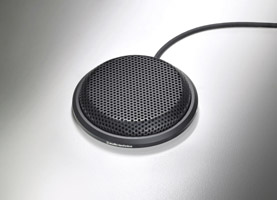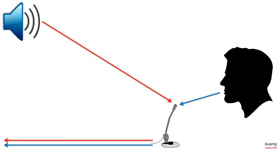3 Ways to Improve Audio Conferencing

At it’s best, audio conferencing is an efficient productivity tool. . .but at it’s worst, it is a barrier to understanding filled with buzzing, humming, and echo. Here are 3 ways to improve your audio conferencing experience and some product recommendations. If you are unsatisfied with your audio conferencing system, give us a call. We can provide a service call to remedy the current problem or assess the whole system and have our sound engineers offer specific suggestions to fix your audio conferencing challenges.
This post addresses the following audio conferencing questions.
How do I achieve the best audio quality?
What types of microphones should I consider?
What is echo cancellation and why is it important?
Achieving Audio Conferencing Quality
 Keep the microphone as close to your mouth as possible audio conferencing boundary microphone
Keep the microphone as close to your mouth as possible audio conferencing boundary microphone
Yes, speak with some volume and clarity, but also know where you microphone is located and speak into it. Keeping a microphone close improves your “signal to noise” ratio and ensures maximum voice and minimum noise.
Utilize automixing and proper gain structures to keep a consistent audio level
Automixing is a live sound mixing device that automatically reduces the strength of a microphone’s audio signal when it is not being used. Audio conferencing spaces often have multiple microphones, so automixers lower the hiss, rumble, reverberation and other extraneous noise that can occur when microphones operate simultaneously. Gain in the simplest sense is an increase in some kind of value. In the audio world, it is an increase in the power signal, which is almost always expressed in dB (decibels). Proper gain structure will manage distortion, thus improving audio quality.
Use acoustic treatments to reduce echo, audio reflection and external noise
These include absorbers, diffusors, sound barriers, construction materials and isolation platforms. There are two main approaches to creating a balance between echo and reflection: absorption and diffusion. Absorption is essential for reducing flutter echoes. Diffusion is the scattering of sound energy using multi‑faceted surfaces, which helps in energy control and improves the sound quality in frequencies. A good acoustic treatment plan can turn a poor audio conferencing experience into an excellent experience. It is equally important to treat the space acoustically as it is to make the right microphone and processing choices. No amount of electronic processing can compensate for poor acoustics in a room.
Microphone Considerations
 Position microphones so they are close to the speaker
Position microphones so they are close to the speaker
Look to achieve a good balance between the current presenter sound and the ambient noise of the room. During audio conferencing any given speaker should be the clear focus, with a moderate amount of ambient surrounding noise. Try to be no further than 3’ from a microphone for general audio conferencing, and no more than 6” for local reinforcement of the microphone. There are some specialty microphones that can be used if these rules cannot be followed, but consult with a qualified systems engineer before attempting those solutions.
Consider microphones with coverage patterns
Use controlled pattern microphones to steer coverage to capture audio where the microphone is positioned, while rejecting unwanted artifacts from sources such as HVAC systems or room equipment fans. Controlled pattern microphones behave much like flashlights, point them at the sound you want, avoid the sound you don’t want.
Target the speaker with directivity
Directivity is related to how a microphone picks up sound from a source depending upon their relative orientation. If the microphone is not ideally positioned for audio conferencing, use a microphone with directivity to target the speaker.
Echo Cancellation
 Break the echo loop
Break the echo loop
Have you ever heard yourself talking through a cell phone call after you have already spoken? No one wants to hear themselves talking back. Echo is the loop that occurs when reinforced sound through the loudspeaker is re-transmitted to the far side, enabling them to hear themselves. Echo cancellation mitigates this by breaking the echo loop.
Cancel the echo
You can’t hear a good echo cancellation algorithm in your conference room, but you can appreciate and benefit from the clarity. Acoustic echo cancellation benefits the far-side in audio conferencing.
Use a digital signal processor
Software based echo cancellers are available, but have not caught up to dedicated echo cancellation processors. Digital Signal Processing (DSP) is all about improving the accuracy and reliability of digital communications by taking a digital signal and processing it to improve the signal into clearer sound.
If you are unsatisfied with your audio conferencing system, contact Diversified today. We can help remedy the current problem or assess your whole AV system and have our sound engineers offer specific suggestions to fix your audio conferencing challenges.



